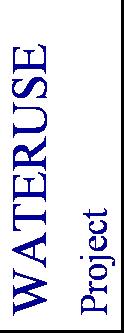 TITLE
OF PROJECT, OBJECTIVES
AND
PROJECT RELEVANCE
TITLE
OF PROJECT, OBJECTIVES
AND
PROJECT RELEVANCE
WORKING PACKAGES EXPECTED IMPACTS
WATERUSE
Energy, Environment and
Sustainable Development Programme
(EVK1-CT-2000-00079 WATERUSE,
EU) TITLE
OF PROJECT, OBJECTIVES
AND
PROJECT RELEVANCE
TITLE
OF PROJECT, OBJECTIVES
AND
PROJECT RELEVANCE
| OBJECTIVES: This project aims to provide
tools for the evaluation of water
fluxes and its
governing processes in the drier regions of Europe, in order to develop guidelines for the sustainable use of water resources. The components of the water budget will be studied at locations in Italy and Portugal, representative for large regions of southern Europe characterised by a shortage of water and seasonal fluctuations in both supply and demand. We intend to quantify the main water fluxes for representative land-use patterns. A consequent step-by-step approach from a single tree to a stand and landscape should allow us to identify critical hydrological variables. |
| PROJECT RELEVANCE: We have to face a worldwide increasing
pressure on the natural
resources. The limited
availability of
water in terms of quantity and quality leads to strong competition
between different users with severe
expression in water scarce
regions. Therefore there is a need to solve the task of water
distribution taking into
account the specific demand on water of each land-use pattern (e.g.
irrigated orchards,
recreation resorts, natural ecosystems) and its related impacts on the
economic, environmental
and social conditions. A sustainable development can only
be achieved if the
local decision (distribution scheme) is embedded in a water management
strategy for the whole water
catchment.
An integrated watershed management
can only be successful if it is based
on the understanding of the physical and
physiological principles of water and solute
movement. Soil water movement and evapotranspiration represent
crucial components of the
hydrological cycle because they are directly linked to plant growth
(production) and
function as a trigger with respect to surface runoff and recharge of
ground- and surface water
which may serve as drinking-water reservoirs.
For the large water deficient regions
of European countries with Mediterranean
climate there exists a lack of knowledge
on evapotranspiration and
survival strategies under
water stress of the dominant stands. These savana-like
landscapes e.g.
with oak trees or olive trees withstand the extremes of wet and dry
seasons during the year.
The lack of knowledge arises because of the lack of appropriate tools,
both sensors and
models, to study those systems. So, we have to develop tools that will
enable us to describe
and quantify the water fluxes within those landscapes.
Irrigation
represents the main consumer of water (with increasing
demands) in the areas under investigation. Natural and seminatural
ecosystems like the
montado may react sensitive to changes in the local water cycle.
Criteria will be derived to determine
priorities for the sustainable use of water resources in
relation to land-use pattern in
order to minimise conflicts. A close co-operation between scientist,
private enterprises,
farmers and institutions all involved in water resources management
will ensure that the project
will focus on contributing to solutions of the above mentioned actual
problems.
|